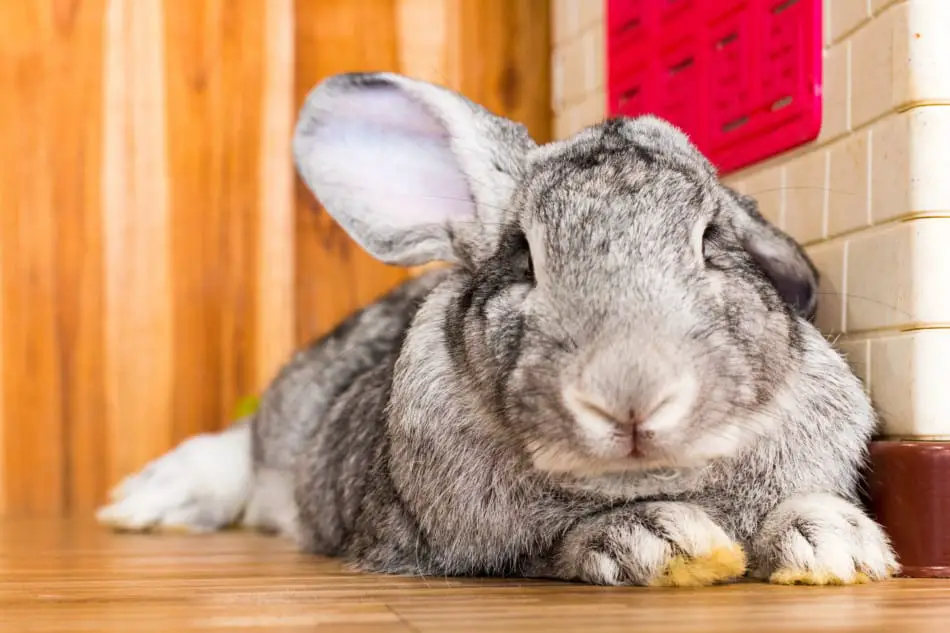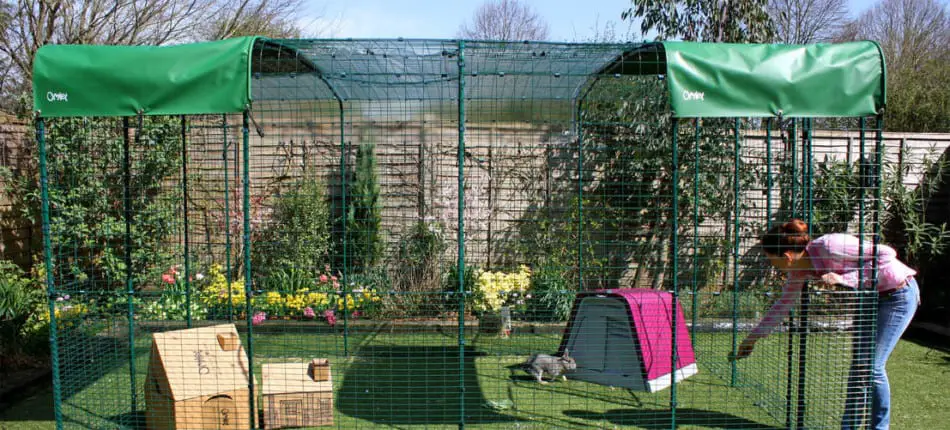True to its name, the Flemish Giant Rabbit is one gigantic bun. At 2.5 feet, they weigh in 12-20 pounds. This makes them the same size as small to medium-size dogs! Imagine one of these grand fellows hopping around your home. But What Is The Lifespan of A Flemish Giant Rabbit I hear you ask?
You can see why someone might want to adopt this extraordinary and adorable animal.
What is the lifespan of a flemish giant rabbit? The lifespan of a Flemish Giant Rabbit is 5 years or more. Like any pet, they have a special diet for optimum health. Equally important is the right environment and proper care. Diet and space to run and play is vitally important for these huge rabbits.
To help your Flemish Giant Rabbit live into their golden years, there are a few things that you will need to know! First off, what is a Flemish Giant Rabbit, anyway?

Table of Contents
What Is a Flemish Giant Rabbit?
Flemish Giant Rabbits are truly giant, compared to your average bun! The common cottontail is a mere 15 to 17-inches long, and 2.5 to 5.5 pounds. Compared to these little guys, the 2.5 foot-long, 12-20 pound Flemish Giant Rabbit is a veritable bear of a bunny… a soft, cuddly bear!
Flemish Giants are not found in the wild naturally. They are thoroughly domesticated and have been for a very long time. In fact, the Flemish Giant is one of the oldest breeds in history.
They are descended from ancient giant rabbit breeds, like the European Patagonian and the Stone Rabbit, some experts believe.
These breeds were raised for fur and meat purposes, and are now extinct, sadly.
The Flemish Rabbit first appeared in Belgium, in the 16th century. In 1893, the extraordinary animals were exported from England to the US. In 1924, they became an official charter breed of the American Rabbit Breeders Association (ARBA).
Owners quickly found the Flemish Giant Rabbit to be intelligent and well-behaved, and easy to train as well. The Flemish giant is a gentle giant, and naturally calm and peaceful.

Just keep in mind that they must be held carefully, so they do not spook. Their legs are quite powerful, and, when frightened, they tend to kick.
Treat your Flemish Giant Rabbit right, and they will reward you with a temperament that is as sweet as can be.
You can find these beautiful short-haired rabbits in a variety of colors, which are: white, sandy, light gray, steel gray, blue, and black.
What Is The Lifespan of A Flemish Giant Rabbit?
In the wild, a Flemish Giant Rabbit would probably not survive. They have been domesticated for too long now. Despite its size, the Flemish Giant Rabbit is still a prey animal and looks like an easy snack.
When left unattended outdoors, the Flemish Giant Rabbit is in danger from dogs, predatory birds, foxes, and more.
In summation, Flemish Giant Rabbits were literally bred to be pets and should live safely in a home (or in a secure outdoor enclosure).
How Can I Help My Flemish Giant Rabbit Live Longer?
Flemish Giant Rabbits are not as long-lived as the common cottontail. They live 5 years on average, sometimes more.
Cottontails live to be 9 or more. You can give your Flemish Giant Rabbit the longest possible lifespan with the proper care and a bit of love!
Flemish Giant Rabbits Require Lots of Space
This is one of the most unique requirements of the Flemish Giant Rabbit! Most buns can be perfectly at home in a cage or hutch. For the Flemish Giant Rabbit, however, these enclosures are much too small.
They are made for 15-17” long rabbits, after all. Instead, your Flemish Giant Rabbit will probably require a kennel. There are also some extra-large cages available online.
Some even opt to dedicate a room in the house to their bun (where they will have their bedding, litter box, and so on)!

Flemish Giant Rabbits Need Plenty of Exercise
Along with a big living space, Flemish Giant Rabbits must have plenty of room to exercise. This means that you will frequently need to let them out of their enclosure to stretch, play, and explore. Just make sure that the area is rabbit-proof!
Fortunately, compared to their smaller cousins, the Flemish Giant Rabbit is calmer and less active.
Frequently Clean Your Flemish Giant Rabbit Cage
One con of the Flemish Giant Rabbit is that, due to their size, they eat more, and create more waste. This means that you will need to clean their living area more frequently than you would for a little bun.
As with any rabbit, hygiene is absolutely key to the health of the Flemish Giant Rabbit overall.
Best cages and runs for Flemish Giant Rabbits
We all know that bunnies love to hop and jump so it’s vitally important that you provide your pet rabbit with plenty of space to have fun. This Outdoor Rabbit Run is just the thing from Omlet.com.
Unlike other metal or Plastic rabbit runs, it has been designed to blend into the backyard, so it looks great and keeps your bunnies safe from predators and other pets.
This safe and secure outdoor run for rabbits and other pets is enclosure is extendable in width, length and height, making it suitable for every breed of rabbit, from Dwarf Lops to Lionheads to Flemish Giants.
Attach this rabbit run to your Eglu Go Rabbit Hutch, place your wooden rabbit hutch inside or simply use as a separate play area for a few hours a day. However you choose to design your rabbit keeping area, this run will give your bunnies lots of space for exercise.

Flemish Giant Rabbits Must Be Clipped and Groomed For Their Health
Flemish giant rabbits have very luxurious fur that is nice and thick. While this is a lovely attribute, it also means that you will need to groom them often. Otherwise, they will ingest too much fur when they groom themselves and develop what is called ‘fur block.’
Flemish Giant Rabbits also have thick nails, due to their size. These will need to be clipped every once in a while, to avoid a condition called ‘sore hock.’
Grooming brushes are available on Amazon here
Flemish Giant Rabbits Need A Positive and Peaceful Home
You must make sure not to expose your Flemish Giant rabbit to excessive activity or noise. Like any rabbit or prey animal, they are extremely sensitive.
They must have an environment that is positive and peaceful for their well-being, and in order to sleep and relax.
Outdoor Flemish Giant Rabbits Must Be Properly Secure
Flemish Giant Rabbits can be kept outdoors, on a few conditions. The biggest concerns are the elements and predatory animals. Provided that it is comfortable, with bedding, a litter box, and so on, you can keep your Flemish Giant Rabbit in a kennel.
To protect from predatory animals, like dogs and foxes, this kennel will need to be durable and appropriately closed-off.
Birds of prey may also attack, so the kennel will need a roof. Additionally, the roof will protect from rain, wind, and the like.
Breeding Decreases The Flemish Giant Rabbit Lifespan
Breeding any animal decreases its lifespan, especially rodents, like rabbits, guinea pigs, and the like. Should you wish to breed your Flemish Giant Rabbit, this is something that you will want to be aware of.
To Live Their Longest, Flemish Giant Rabbits Must Eat Properly
Since Flemish Giant Rabbits are up to 10 times the size of your average rabbit, they need much more food to consume. Should you be considering adopting a Flemish Giant Rabbit, you will have to buy food often to keep them in stock!
Like most rabbits, Flemish Giant Rabbits should eat mostly hay. Timothy hay is a particularly nutritious choice. Recommended is to buy this in bales, to save on money, effort, and time.

The Flemish Giant Rabbit should also have high-quality pellets each day! These big fellows require 16% protein in their diet, to maintain their great girth (and health).
Pellets will provide them with protein, along with vitamins, fiber, and more.
Conclusion: Flemish Giant Rabbit Lifespan
So, Flemish Giant Rabbits live 5 years on average. There are things that you can do to make sure that they reach this age, and they can live even longer, with special care. Just give them a clean, spacious home, frequent freedom to roam, plenty of nutritious food… and of course, plenty of attention and love!





